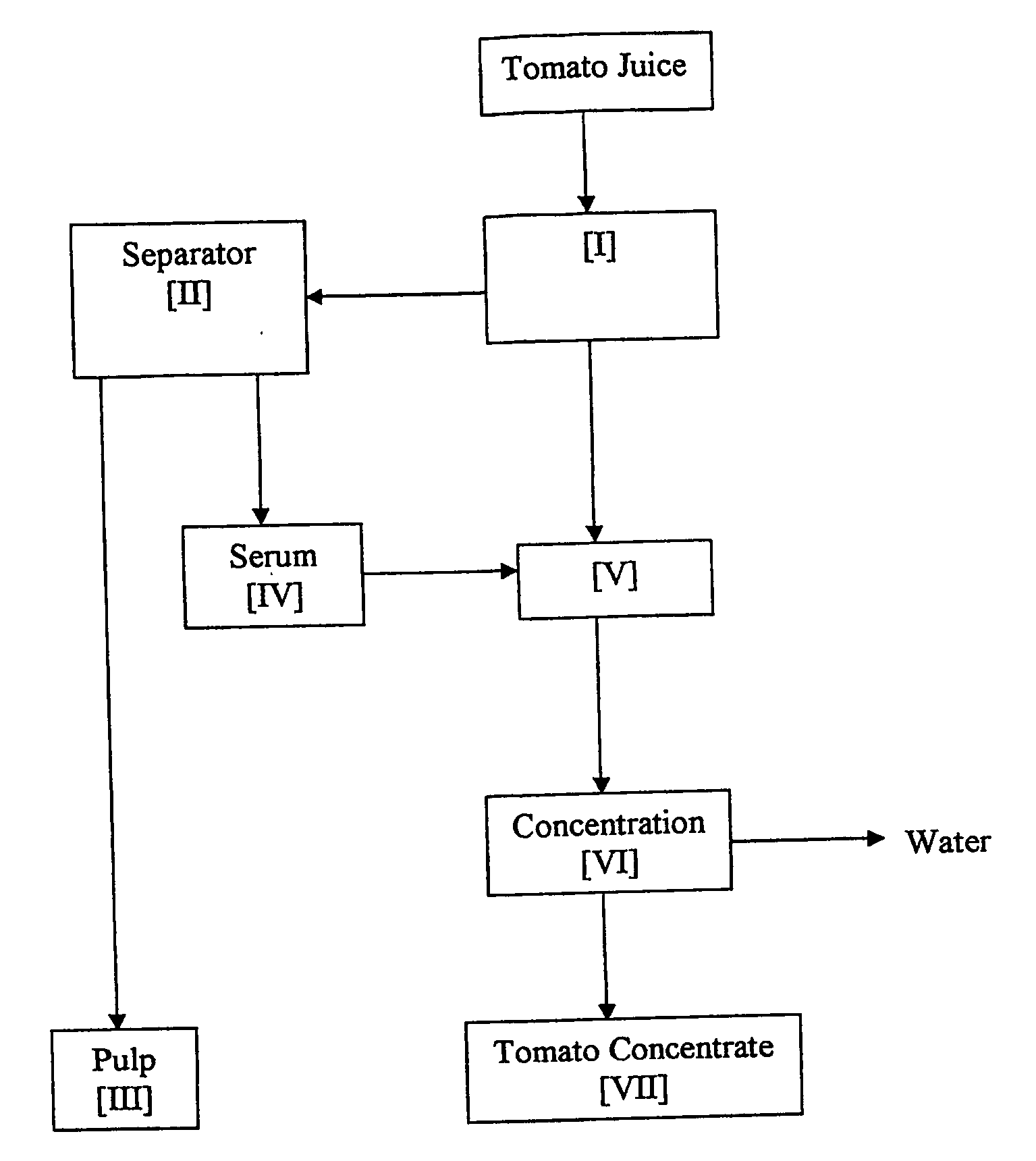Industrial tomato process and product obtained thereof
a technology of tomato pulp and tomato concentrate, which is applied in the field of tomato processing and products, can solve the problems of lowering the viscosity of the resultant tomato juice, unfavorable industrialization, and unfavorable economic development, and achieves the effect of high water absorbency capacity ratio
- Summary
- Abstract
- Description
- Claims
- Application Information
AI Technical Summary
Benefits of technology
Problems solved by technology
Method used
Image
Examples
example 1
Process for Obtaining Tomato Concentrate—Control
[0035] The present Example describes a process in accordance to known industrial processes. 30 ton / hr tomato feed (Brigade variety from BetHashita Farm, 5° Brix and about 10 ppm lycopene)—after washing, sorting, crushing, hot break heating to 95° C. and finishing through Rossi & Catelli 0.8 mm screen, is fed to an evaporator. The product obtained after evaporation has a Brix of 30° and a Bostwick value of 5.0. Wherein Bostwick is a measure of viscosity according to the Bostwick method. The product is diluted to 8° Brix and the flavor are tested as reference. The Lycopene content in the final product is 410 ppm and the a / b value was 2.0 as tested by Hunter tristimulus calorimeter.
example 2
Process for Obtaining Tomato Pulp and Tomato Concentrate from Tomato Juice
[0036] 30 ton / hr tomato feed (Brigade variety from BetHashita Farm 5° Brix, 120 ppm lycopene), after washing sorting crushing hot break heating to 95° C. and finishing through Rossi & Catelli 0.8 mm screen, are split into two streams: Stream one, 7 ton / hr is fed to a decanter (centrifugal separator) which separates the tomato juice to 0.8 ton tomato pulp containing 91% moisture. The removal of said pulp may effect the a / b color ratio that correlates with lycopene content and the color of the final tomato concentrate 6.2 ton / hr serum is then added to stream two.
[0037] Stream two—23 ton / hr tomato juice and 6.2 ton / hr serum from stream one is fed to an evaporator. The product of 30° Brix has the same texture as the tomato concentrate described in Example 1 and a Bostwick of 5.5 (measured at a Brix of 12°) and the color a / b value=1.98.
[0038] The tomato concentrate is diluted to 8° Brix, 7° Brix, 60 Brix and tes...
example 3
Tomato Concentrate Preparation—Comparative Example
[0040] Stream 1-7 ton / hr tomato feed (Brigade variety from BetHashita Farm 5° Brix)—after washing sorting crushing finishing through Rossi & Catelli 0.8 mm screen at ambient temperature and then heating to 90° C., is fed to a decanter which separates the tomato juice to 0.4 ton tomato pulp containing 81% moisture and 6.6 ton / hr serum.
[0041] Stream 2-25 ton / hr tomato feed (Brigade verities from BetHashita Farm 5° Brix)—after washing sorting crushing hot break heating to 95° C. and finishing through Rossi & Catelli 0.8 mm screen, are mixed with the 6.6 ton / hr serum from stream 1, and fed to the tomato evaporator. The tomato concentrate obtained is of 30° Brix having a low viscosity of 9.5 Bostwick. This tomato concentrate is not suitable for the regular tomato concentrate applications.
PUM
 Login to View More
Login to View More Abstract
Description
Claims
Application Information
 Login to View More
Login to View More - R&D
- Intellectual Property
- Life Sciences
- Materials
- Tech Scout
- Unparalleled Data Quality
- Higher Quality Content
- 60% Fewer Hallucinations
Browse by: Latest US Patents, China's latest patents, Technical Efficacy Thesaurus, Application Domain, Technology Topic, Popular Technical Reports.
© 2025 PatSnap. All rights reserved.Legal|Privacy policy|Modern Slavery Act Transparency Statement|Sitemap|About US| Contact US: help@patsnap.com


